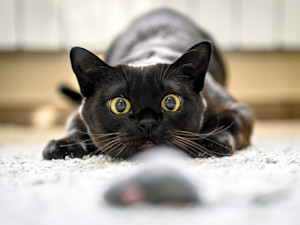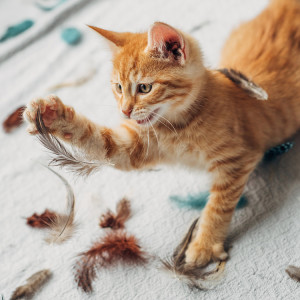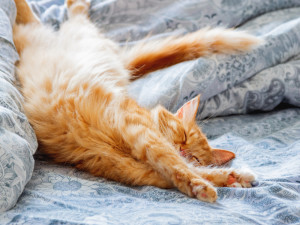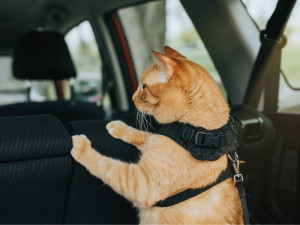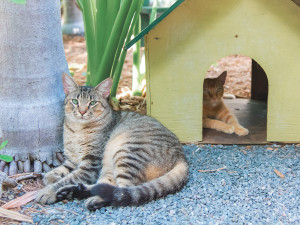
share article
Have you ever watched your cat jump from the counter to the fridge with no issue at all? Even if they’re not supposed to be on either surface, they’re basically an Olympic athlete with those skills. Besides being simultaneously impressed and terrified, you might also be wondering: just how high can my cat jump?
A cat’s vertical jump height
Cats do all sorts of weird and wild things, but their jumping skills might just be one of the most notable. It’s not uncommon for them to leap up to nine times their heightopens in a new tab. Many cats don’t even need a running start to soar; they can jump 8ft from a standing position.
Why can cats jump so high?
Think your cat is all catnaps, headbuttsopens in a new tab, and purrsopens in a new tab? Think again. Your loafin’ feline is actually a fierce predatoropens in a new tab who stalks their next meal at dusk and dawn. In other countires, they’re also prey for larger animals like coyotes and eagles.
OK, OK, your cat isn’t going to get eaten by a hawk, and they might even get white-glove table service, but they do retain all the necessary adaptations to catch their next meal and safely escape the claws of predators. With powerful back legs propelling them high off the ground, they put these skills to good use in everyday tasks, like play, exploration and (sometimes) swiping food from the counter.
Contributing physical factors
Cats are built for agility, says Dr Colleen Lamboopens in a new tab, a veterinarian at the mobile veterinary service The Vetsopens in a new tab. According to her, here are some physiological features that make them so nimble:
Powerful hind limbs: cats’ back legs have powerful muscles designed for explosive bursts of energy. “Particularly the quadriceps and gastrocnemius contribute to the force generated during a jump,” says Dr Lambo.
Flexible spine: cats have a more flexible spine than many other animals, allowing them to twist, contort and arch their backs to fully extend their hind limbs and even adjust in midair for precise landings.
Elastic tendons and ligaments: stretchier tendons and ligaments efficiently store and release energy during jumps for a quick and powerful launch.
Strong core muscles: a strong core stabilises the body during a jump.
Long limbs: cats’ back legs are relatively long compared to their body size, which provides an advantageous lever system for generating force. (And you thought physics lessons were a waste.)
Retractable claws: cats’ claws act as little spikes to gain traction during takeoff and landing.
Excellent depth perception: feline eyesightopens in a new tab is pretty wild. They have the ability to accurately gauge distances by sight. Cats’ superciliary (above the eye) whiskers, mandibular (muzzle) whiskers, and carpal (wrist) whiskers act like little antennas and built-in tape measures, enhancing this precision.
Specialised toes: have you noticed that, unlike humans who walk on their heels, cats walk on their toes? Called digitigrade locomotionopens in a new tab, it gives them a spring-like leap.
Shock absorbers: “The tarsal (ankle) bones act as shock absorbers, enhancing their ability to absorb the impact of landing,” explains Dr Lambo.
Breed impacts on jumping ability
A cat’s jumping ability is more about their physical limitations and health than their breed since they’re all made with the same stuff. That said, Dr Lambo explains there are a few particular breeds known for their muscular physique and overall athleticism, including:
Abyssinian
Bengal
Savannah
Oriental Shorthair
Siamese
Cornish Rex
Devon Rex
Maine Coon
There isn’t a Guinness World Record for the highest vertical jump but Waffle the Warrior Catopens in a new tab (a tuxedo kitty resembling none of the aforementioned breeds) holds the record for the longest leap at 7ft. Meanwhile, Savannah cats are said to be able to jump over 10ft, and if you’re wondering how high a Bengal cat can jump, they can leap as high as 8ft.
Short-legged feline friends, such as Munchkins or those prone to arthritis or genetic disorders such as Scottish Folds, typically don’t reach such great heights.
Risks of high jumps
There isn’t a defined limit to how high cats can jump down. And stories of cats falling from buildings and landing on their feet (thanks to the righting reflex) may leave you believing that great heights are no feat for cats.
But cats don’t always land on their feet. Even if they do, many suffer injuries like bone fracturesopens in a new tab. The risks can increase when jumping to or from unsafe or unsteady surfaces, especially for cats with health conditions or injuries, or if your cat is a senior. A good rule of thumb is to provide plenty of safe jumping surfaces, such as sturdy cat treesopens in a new tab and cat shelving with non-slip surfaces.
“For senior cats, especially those with age-related changes in mobility or health conditions, it’s essential to consider safety precautions when it comes to jumping activities,” says Dr Lambo. She offers the following tips for encouraging safe play and exercise:
No matter your cat’s age, maintain a healthy weight to reduce stress on joints. Your veterinarian can help you establish a diet and feeding plan tailored to your cat.
Opt for low-impact activities that are easy on the joints, like gentle play with soft toys, slow-paced interactive games, or short periods of time outside.
Create easily accessible elevated spaces, such as low platforms or padded perches. Consider using pet stairs or ramps to make higher areas more accessible.
Place soft, cushioned surfaces around areas where your cat likes to jump to help reduce the impact on joints and provide a comfortable landing surface.
Even if your cat seems healthy, don’t skip regular veterinary check-ups. “Early detection and management of conditions like arthritis can significantly improve a cat’s quality of life,” says Dr Lambo.
Frequently asked questions
Is there a world record for the highest cat jump?
There’s no Guinness World Record for the highest vertical jump by a cat but the title for longest horizontal jump goes to Waffle the Warrior Catopens in a new tab. He’s a 10-year-old tuxedo with a mighty 7ft leap.
Can a cat jump 7ft?
Most domestic house cats can vertically jump nine times their height, which averages about 8ft from a standing position! Some cat breeds, like Savannah cats, can even jump to remarkable heights over 10ft. Older cats and those with genetic conditions may keep all four paws closer to the ground.
How can I keep my cat safe when jumping?
Jumping, climbing and pouncing are all natural behaviours of a cat and a great way for them to exercise. Provide your cat with plenty of safe jumping surfaces, such as sturdy cat trees and shelves with traction. If you’re worried about your cat jumping down from high spots, Dr Lambo recommends padding the landing zone with soft surfaces. To ensure your senior cat can still access their favourite perch, consider offering pet stairs or a ramp.
Do cats always land on their feet?
Cats don’t always land on their feet, but they do have something called the ‘righting reflex’, which allows them to twist their body during a fall to land on their feet most of the time. But if they fall from too low of a height, they may not have enough time to contort their bodies. Falling from too great of a height can still result in injuries even if the cat makes a near-perfect landing.
References:

Janelle Leeson
Janelle Leeson is a Portland, Oregon-based freelance writer. Her work has been featured in magazines such as Inside Your Dog’s Mind, Inside Your Cat’s Mind, and Paw Print, as well online at Insider Reviews, NBC Select, Shop Today, PetMD, and Daily Paws. She has two adventure cats, a flock of urban chickens, and a soon-to-be-husband who doesn’t mind housing the occasional foster cat — or five.
Related articles
![Cat stretching on blue bedding]() opens in a new tab
opens in a new tab5 Calming Products For Cats
Because when you interrupt that carefully planned daily routine, there’s going to be one frazzled kitty to deal with
![Cat standing up in the back of a car]() opens in a new tab
opens in a new tabHow to Travel With a Cat (Without a Scratch)
Everything you need to bring your cat home for Christmas, including calming products and a portable litter box
![Cat laying inside a cat tree]() opens in a new tab
opens in a new tabCat Trees That Won’t Clash With Your Aesthetic
Stylish cat trees for every home and personality, from cartoon flowers to modernist towers
![Hemingway cat at hemingway Home and Museum in Key West]() opens in a new tab
opens in a new tab6 Facts About Polydactyl Cats
What makes the fabled ‘Hemingway cats’ so special
![Woman feeds gray cat dry food.]() opens in a new tab
opens in a new tabDoes Your Cat Need a High-Protein Diet Like the Lads At the Gym?
While they might not be working on their ‘gains’, there are other reasons this diet could be a good fit
- opens in a new tab
Are Cats Liquid?
Like, no. But also… yes? Right?
